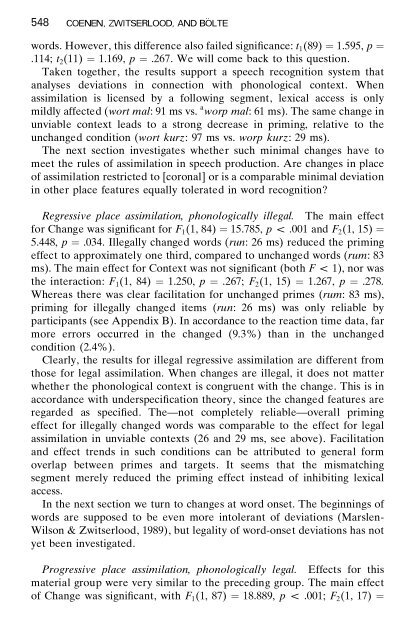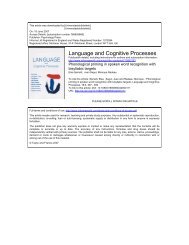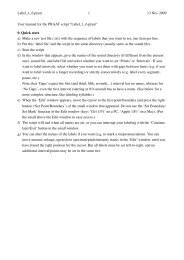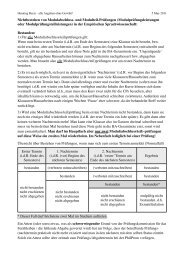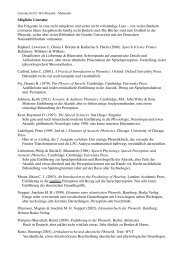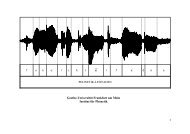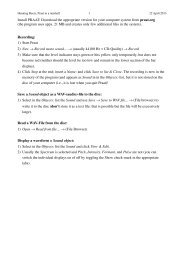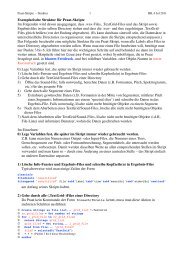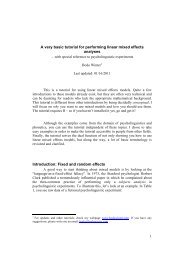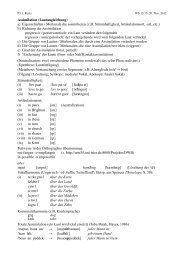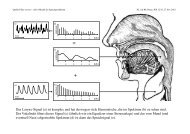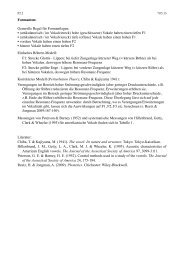Variation and assimilation in German - Institut für Phonetik
Variation and assimilation in German - Institut für Phonetik
Variation and assimilation in German - Institut für Phonetik
You also want an ePaper? Increase the reach of your titles
YUMPU automatically turns print PDFs into web optimized ePapers that Google loves.
548 COENEN, ZWITSERLOOD, AND BOÈLTE<br />
words. However, this difference also failed signicance: t 1(89) ˆ 1.595, p ˆ<br />
.114; t 2(11) ˆ 1.169, p ˆ .267. We will come back to this question.<br />
Taken together, the results support a speech recognition system that<br />
analyses deviations <strong>in</strong> connection with phonological context. When<br />
<strong>assimilation</strong> is licensed by a follow<strong>in</strong>g segment, lexical access is only<br />
mildly affected (wort mal: 91 ms vs. a worp mal: 61 ms). The same change <strong>in</strong><br />
unviable context leads to a strong decrease <strong>in</strong> prim<strong>in</strong>g, relative to the<br />
unchanged condition (wort kurz: 97 ms vs. worp kurz: 29 ms).<br />
The next section <strong>in</strong>vestigates whether such m<strong>in</strong>imal changes have to<br />
meet the rules of <strong>assimilation</strong> <strong>in</strong> speech production. Are changes <strong>in</strong> place<br />
of <strong>assimilation</strong> restricted to [coronal] or is a comparable m<strong>in</strong>imal deviation<br />
<strong>in</strong> other place features equally tolerated <strong>in</strong> word recognition?<br />
Regressive place <strong>assimilation</strong>, phonologically illegal. The ma<strong>in</strong> effect<br />
for Change was signicant for F 1(1, 84) ˆ 15.785, p < .001 <strong>and</strong> F 2(1, 15) ˆ<br />
5.448, p ˆ .034. Illegally changed words (run: 26 ms) reduced the prim<strong>in</strong>g<br />
effect to approximately one third, compared to unchanged words (rum: 83<br />
ms). The ma<strong>in</strong> effect for Context was not signicant (both F < 1), nor was<br />
the <strong>in</strong>teraction: F 1(1, 84) ˆ 1.250, p ˆ .267; F 2(1, 15) ˆ 1.267, p ˆ .278.<br />
Whereas there was clear facilitation for unchanged primes (rum: 83 ms),<br />
prim<strong>in</strong>g for illegally changed items (run: 26 ms) was only reliable by<br />
participants (see Appendix B). In accordance to the reaction time data, far<br />
more errors occurred <strong>in</strong> the changed (9.3%) than <strong>in</strong> the unchanged<br />
condition (2.4%).<br />
Clearly, the results for illegal regressive <strong>assimilation</strong> are different from<br />
those for legal <strong>assimilation</strong>. When changes are illegal, it does not matter<br />
whether the phonological context is congruent with the change. This is <strong>in</strong><br />
accordance with underspecication theory, s<strong>in</strong>ce the changed features are<br />
regarded as specied. The—not completely reliable—overall prim<strong>in</strong>g<br />
effect for illegally changed words was comparable to the effect for legal<br />
<strong>assimilation</strong> <strong>in</strong> unviable contexts (26 <strong>and</strong> 29 ms, see above). Facilitation<br />
<strong>and</strong> effect trends <strong>in</strong> such conditions can be attributed to general form<br />
overlap between primes <strong>and</strong> targets. It seems that the mismatch<strong>in</strong>g<br />
segment merely reduced the prim<strong>in</strong>g effect <strong>in</strong>stead of <strong>in</strong>hibit<strong>in</strong>g lexical<br />
access.<br />
In the next section we turn to changes at word onset. The beg<strong>in</strong>n<strong>in</strong>gs of<br />
words are supposed to be even more <strong>in</strong>tolerant of deviations (Marslen-<br />
Wilson & Zwitserlood, 1989), but legality of word-onset deviations has not<br />
yet been <strong>in</strong>vestigated.<br />
Progressive place <strong>assimilation</strong>, phonologically legal. Effects for this<br />
material group were very similar to the preced<strong>in</strong>g group. The ma<strong>in</strong> effect<br />
of Change was signicant, with F 1(1, 87) ˆ 18.889, p < .001; F 2(1, 17) ˆ


